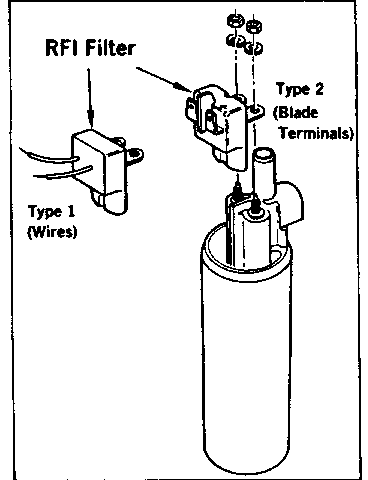NO START / NO RUN BLOWN FUEL PUMP FUSE

MODELS AFFECTED: 1984-1985 CIMARRONS EQUIPPED WITH 2.0L ENGINE (VIN CODE P) 1985 FWD "C" EQUIPPED WITH HT4100 (VIN CODE 8)
Some vehicles may experience a no run or no start condition and/or fuel pump fuse blown caused by a short or open in the Radio Frequency Interference (RFI) filter in the fuel tank. The RFI filter is located on the electrical input terminals of the in-tank electric fuel pump (see Figure 1).
To diagnose:
1985 FWD "C"
See 1985 FWD Fleetwood and Deville Service Information Manual, Section 6E, Chart A-4, "Fuel System Diagnosis." The chart has been revised to include diagnosis for an open or shorted RFI suppression filter, and was included in the loose-leaf Service Information Manual revision mailed July 1, 1985. To prevent the possibility of misdiagnosis or wasted diagnostic time, please verify that Chart A-4 in your Service Manual has been replaced with the July 1 revision page.
1984-1985 Cimarron
Disconnect the fuel tank connector. Mechanical instrument cluster equipped cars will have a three (3) wire connector and digital cluster equipped cars will have a four (4) wire connector. On both 3 and 4 wire connectors, the fuel pump feed (12V) is terminal "C" (a tan wire) and ground is terminal "A" (a black wire). On the fuel tank connector, measure resistance between pin "A", black wire and pin "C" tan wire, using a digital multimeter, J-29125A, J-34029, or equivalent. A 3-4 OHM resistance indicates that the wiring and connectors inside the tank are okay -- see appropriate Cimarron Service Information Manual, Section 6E2, to diagnose for cause of customer complaint condition.
If the resistance reading indicates an open or a short, the sending unit must be removed from the vehicle to diagnose.
- Check for opens or shorts in sending unit wiring from the connector at the top of the sending unit to the RFI suppression filter on the fuel pump. If shorts or opens are found, repair the wiring or replace the sending unit as necessary.
- Measure the resistance of the fuel pump. Resistance should be 3-4 OHMS. If open or shorted, replace the fuel pump with the appropriate service part number.
- Check the RFI suppression filter for shorts between the positive and negative terminals and for opens in positive spade terminal to positive fuel pump eyelet and negative spade terminal to negative fuel pump eyelet. If the RFI filter is shorted or open, replace using the appropriate service part number listed below.
Service Procedure:
The service procedure for each type of RFI suppression filter is included as an instruction sheet with the RFI suppression filter kit. The RFI suppression filter kit will include the RFI filter, nuts and washers for attachment of the filter to the fuel pump, a new fuel pump to sending unit rubber coupler hose and a new sending unit 0-ring.
Parts Information: RFI SUPPRESSION FILTER KIT APPLICATION SERVICE PART NUMBER ----------- ------------------- 1984 Cimarron (2.0L VIN Code P) 6472781 1985 Cimarron (2.0L VIN Code P) 6472779 1985 FWD "C" (4.1 L VIN Code 8) 6472781 (Type 1, Integral Wire)1 1985 FW D "C" (4.1 L VIN Code 8) 6472779 (Type 2, Blade Terminals)1
1The RFI suppression filter for the DFI equipped FWD "C" can either be type 1 or type 2 (see Figure 1). All service stock of sending units P/N 25004983) will require that a type 2 (blade terminal type) RFI connector be used. When replacing a sending unit in a 1985 FWD "C" that was originally equipped with the type 1 filter, the service sending unit (P/N 25004983) will be the type 2 design; therefore, it is necessary to also order the type 2 filter, P/N 6472779.
Some fuel pump (P/N 6472358) service kits or sending unit (P/N 25004993) service kits may include a black RFI suppression connector as a part of the service kit. If a black filter is included with the pump or sender, do not use the black filter, use a P/N 6472779 filter which is green in color.

General Motors bulletins are intended for use by professional technicians, not a "do-it-yourselfer". They are written to inform those technicians of conditions that may occur on some vehicles, or to provide information that could assist in the proper service of a vehicle. Properly trained technicians have the equipment, tools, safety instructions and know-how to do a job properly and safely. If a condition is described, do not assume that the bulletin applies to your vehicle, or that your vehicle will have that condition. See a General Motors dealer servicing your brand of General Motors vehicle for information on whether your vehicle may benefit from the information.
